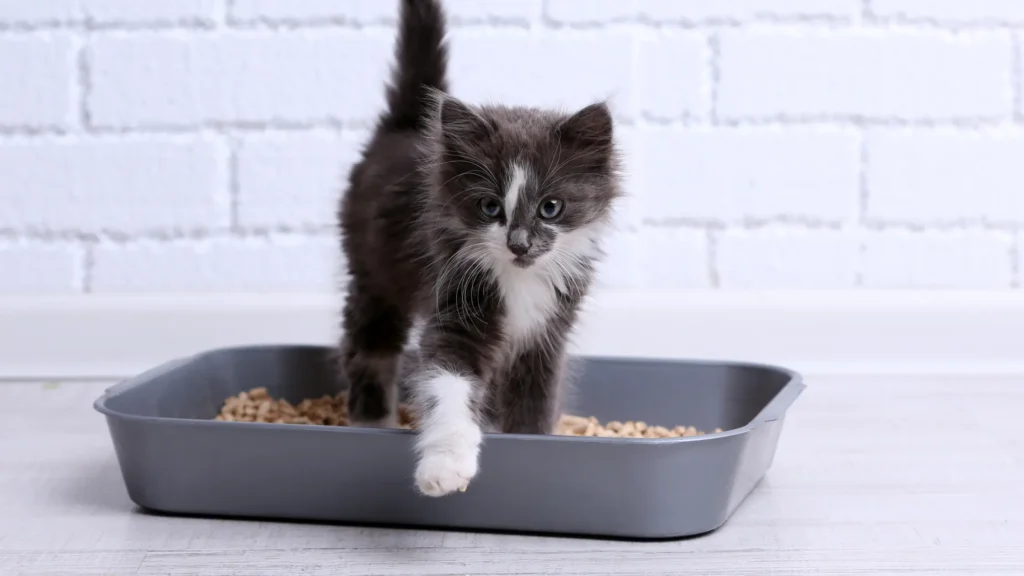Introduction
How to train a kitten to use a litterbox: Training a kitten to use a litterbox is an essential aspect of cat ownership. By following proper techniques and providing positive reinforcement, you can teach your kitten to use the litterbox effectively. This comprehensive guide will walk you through the process, from understanding your kitten’s needs to troubleshooting common problems.
Understanding Your Kitten’s Needs
Before you begin litterbox training, it’s crucial to understand your kitten’s natural instincts and behaviors. Kittens have an innate desire to bury their waste, making litterbox training a relatively straightforward process. However, they may need guidance and patience as they learn.
Instinctual Behavior of Kittens
Kittens instinctively seek out a designated area for elimination, preferably one that offers privacy and cleanliness. Understanding this natural behavior can help you choose the right litterbox and location for training.
Choosing the Right Litterbox
Select a litterbox that is appropriately sized for your kitten and easy for them to access. Avoid covered litterboxes initially, as they may feel confining to a young kitten. Opt for a shallow box with low sides to accommodate their small stature.
Selecting the Right Litter
Choose a litter that is safe for kittens and free of strong scents or additives. Unscented, clumping litter is often preferred, as it mimics the texture of sand or soil, which kittens naturally gravitate towards.
Finding the Ideal Location
Place the litterbox in a quiet, easily accessible location away from your kitten’s food and water bowls. Ensure the area is well-ventilated and free from loud noises or distractions that may deter them from using the litterbox.
Establishing a Training Routine
Consistency is key when it comes to litterbox training. Establishing a routine and providing positive reinforcement will help reinforce desired behaviors and encourage your kitten to use the litterbox consistently.
Introducing Your Kitten to the Litterbox
Gently introduce your kitten to the litterbox by placing them inside shortly after meals or naps when they are likely to need to eliminate. Allow them to explore the litterbox at their own pace and avoid forcing them to use it.
Encouraging Positive Associations
Encourage your kitten to associate the litterbox with positive experiences by placing treats or toys nearby. Praise them enthusiastically when they use the litterbox correctly and avoid scolding or punishing them for accidents.
Establishing a Regular Schedule
Establish a regular schedule for feeding and litterbox breaks to help your kitten develop consistent elimination habits. Take them to the litterbox after meals, naps, and play sessions, and monitor their behavior for signs that they need to use the litterbox.
How To Train A Kitten To Use A Litterbox
Most cats will instinctively use litterboxes without needing any particular training since using your rock-hard floor or even worse a fluffy carpet is something unnatural to them.
However, kittens are much more unpredictable since they are young and have not yet learned what is correct and what is not.
It is therefore important to teach them to use a litterbox as soon as possible to prevent the bad habit of pooping and peeing everywhere from forming. Kittens may not be as easy to train as puppies, but don’t let this discourage you, the process is quite simple.
There are 7 steps you should follow in order to train your kitten to use a litterbox as quickly as possible.
Step 1: Make sure you have the right equipment
To train your kitten to use a litterbox the basic equipment you should have, is obviously a litterbox and litter. But how can you know which one is the right one? Let’s get right into it.
Litterbox: Finding the perfect litterbox is not as simple as you may imagine. You need something that is just the right size for your kitten, with low sides for it to easily get in and out. In addition, your litterbox should be safe and easy for kittens to dig in so be careful when picking out a litterbox from your local pet store.
If you can’t seem to find anything of value or are confused to what would make a good litterbox we would highly recommend trying out the lucky champ litter pan. It is elegant, innovative, and will fit any home décor but more importantly it has one high wall to prevent any litter from scattering all over your floor as well as one low front entrance which makes it easy for kittens or old cats to climb in. As for its size, its dimensions are 25×16.75×9 inches making it ideal for cats of all sizes. Its price may be a little higher, but it really is one of the best, high-quality litterboxes you will find.
Litter: Just like the litterbox, it is important to purchase the right litter for your kitten. We would highly recommend the fresh step clumping cat litter which effectively clumps cat litter and eliminates all odors making the process more pleasant for both you and your kitten.
Step 2: Make Sure You Place The Litterbox In The Correct Spot
The placement of your kitten’s litterbox will make a huge difference and is perhaps the most important step of them all.
Like us, kittens hate it when their litterbox is next to or even close to their food bowl so make sure they are in different rooms or that they at least have a good amount of distance in between them.
In addition, you should also place the litterbox in a place that is well lit and gets enough sunlight throughout the day. It would also be preferrable if you placed it close to a door or window for good ventilation.
Step 3: Show Your Kitten The Litterbox
At first you can help your kitten find the litterbox by guiding it to it or even placing it directly in the litterbox after their meals or after they wake up from a nap.
Eventually after doing this a couple of times your kitten will start making its way to the litterbox without any help. You can also gently scratch the surface of the litter with your finger to encourage them to investigate.
Step 4: Reward Good Behavior
Kittens, much like dogs, love praise. By being there when or after they used the litterbox you can reward them with treats (temptations classic crunchy are highly recommended), gentle praises, or affectionate cuddles all of which prove to be extremely effective.
If, however, an “accident” happens and they go somewhere else instead of the litterbox, do not show them the litterbox and tell them off or punish them since they will eventually associate the litterbox with punishment and will never start using it.
Step 5: Keep The Box Clean.
It is also advised to clean the litterbox at least once a week and even more often if it used by more than one kitten. Keeping the litterbox clean will encourage your kitten to keep using it, while too many feces will eventually lead to it picking another place to poop.
Step 6: Immediately Clean Up Any Accidents.
In addition to keeping your litterbox clean, you should also immediately clean up any other areas they used to go to the bathroom with vinegar and water and maybe even place their food bowl on top to ensure they do not use the same area again.
Step 7: Remain Consistent and Patient.
The most important thing when it comes to any type of training, no matter if it is a cat or a dog, is to be patient and remain consistent. Follow the same steps every single day and eventually you will get the result you want.
The time it will take will vary from kitten to kitten, but the results are undeniable.
To conclude, training your kitten to use a litterbox is a simple process which will always result in success if you are patient, consistent and use plenty of positive reinforcement techniques. Harsh punishments or angry behavior are never the answer and if anything can make the situation worse.
FAQs About How To Train A Kitten To Use A Litterbox
How long does it take to litterbox train a kitten?
Litterbox training can vary depending on the individual kitten and their willingness to learn. Some kittens may learn quickly within a few days, while others may take several weeks to establish consistent litterbox habits.
What should I do if my kitten refuses to use the litterbox?
If your kitten refuses to use the litterbox, try adjusting the location or type of litterbox, providing positive reinforcement, and maintaining a consistent training routine. If issues persist, consult your veterinarian for further advice.
Is it normal for kittens to have accidents during litterbox training?
Yes, accidents are common during the litterbox training process, especially in the early stages. Be patient and continue to reinforce positive behaviors while cleaning up accidents promptly to prevent re-soiling.
Should I punish my kitten for accidents outside the litterbox?
No, punishing your kitten for accidents can create negative associations with the litterbox and may lead to further problems. Instead, focus on providing positive reinforcement for using the litterbox correctly and cleaning up accidents promptly.
Can I train multiple kittens to use the same litterbox?
Yes, multiple kittens can share the same litterbox, but it’s essential to provide enough litterboxes for each kitten in the household. Some kittens may prefer their own designated litterbox, so monitor their behavior and adjust accordingly.
What should I do if my kitten eats litter?
If your kitten eats litter, it’s essential to switch to a kitten-safe litter and monitor their behavior closely. Ingesting litter can be harmful, so consult your veterinarian for advice on preventing this behavior and ensuring your kitten’s safety.
Conclusion
Litterbox training is an essential aspect of kitten care that requires patience, consistency, and positive reinforcement. By understanding your kitten’s needs, establishing a training routine, and providing support along the way, you can successfully train your kitten to use the litterbox. Remember to be patient, celebrate small victories, and seek veterinary advice if needed to ensure a positive and successful training experience.
Useful Equipment
So, let us know did you find this article helpful? Did you follow the steps we recommend? Are there any other questions you would like us to answer?
Let us know about your experiences with these dogs in the comment section down below.
If you are a dog or pet lover in general here are a few more articles you may find interesting:
- THE TOP 10 MOST EXPENSIVE CATS IN THE WORLD
- HOW TO GET YOUR DOG OR PUPPY TO STOP BARKING
- HOW TO TEACH YOUR DOG TO ROLL OVER
- HOW TO LEASH TRAIN YOUR DOG
- HOW TO TEACH YOUR DOG TO SHAKE
- HOW TO TEACH YOUR PUPPY NOT TO BITE



